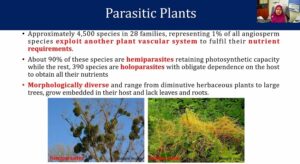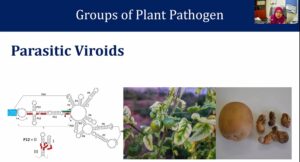 Dr. Zaiton Sapak from Universiti Teknologi MARA Malaysia delivered material on parasitic plants in the Parasitology Lecture Sharing session (3/10). Parasitic plants, or parasitic plants, are organisms that settle on host plants through special organs. “This special organ develops and penetrates the host’s vascular tissue and meets the nutritional, water, and mineral needs of the host plant,” began Dr. Zaiton Sapak. It is said that nearly 4,500 species in 28 families, representing 1% of all angiosperm species, utilize the vascular systems of other plants to meet their nutritional needs.
Dr. Zaiton Sapak from Universiti Teknologi MARA Malaysia delivered material on parasitic plants in the Parasitology Lecture Sharing session (3/10). Parasitic plants, or parasitic plants, are organisms that settle on host plants through special organs. “This special organ develops and penetrates the host’s vascular tissue and meets the nutritional, water, and mineral needs of the host plant,” began Dr. Zaiton Sapak. It is said that nearly 4,500 species in 28 families, representing 1% of all angiosperm species, utilize the vascular systems of other plants to meet their nutritional needs.
Sharing session guided by Purwatiningsih, S.Si., M.Si., Ph.D. The lecturer at the Department of Biology also explained that parasitic plants are divided into several types, seen as being photosynthetically active (hemiparasites), lacking photosynthetic activity, completely bound to the host for carbon (holoparasites), optional or obligate parasites, and attached to the roots or stems of their hosts. “Parasitic plants” grow in agroecosystems with low biodiversity, and their presence causes huge yield losses on agricultural land,” said Dr. Zaiton Sapak.
Parasitic plants must synchronize their life cycles with their hosts for maximum fitness. It was also explained that some species are optional parasites that can survive without a host, while other species are parasites and cannot develop independently. “There is a so-called successful haustorial connection with the host causing permanent damage to most of the plant’s life cycle, reducing crop yields, lowering crop value, and contaminating parasitic seeds,” she explained.
Dr. Zaiton Sapak also explained about pathogenic fungi, some of which are classified as necrotrophs. These fungi are usually saprophytic and can survive well as sclerotia, spores, or mycelia on dead host material in the absence of a living host. “Given the opportunity, this fungus becomes a parasite, killing and then consuming dead plant tissue,” she continued.
Mentioning pathogenic bacteria, as is known, bacteria are single-celled microorganisms, generally measuring between 1-2 µm and cannot be seen with the naked eye. “Plant pathogenic bacteria in nature most often occur in plant remains left on the surface of the soil, in and on seeds, in the soil, and are associated with perennial hosts; there are also some in water and some in or on insects,” she explained.
Pada sharing session yang diadakan secara daring ini dijelaskan mengenai virus parasit. Virus ada beragam kelompok yang menginfeksi inang mulai dari tumbuhan uniseluler hingga pohon dan ukuran virus itu bersifat ultramikroskopis. Dr. Zaiton Sapak mengatakan virus menginfeksi struktur seluler inang dan mengendalikan sebagian sistem subseluler tumbuhan. Dan replikasi virus bergantung pada perakitan kumpulan partikel baru dari komponen yang diperlukan.
“Lanjut kita bahas tentang viroid parasit yang merupakan agen infeksi yang hanya terdiri dari RNA tanpa lapisan pelindung seperti lapisan protein,” tuturnya. Viroid dapat menyusup ke sel tumbuhan hanya jika membran disekitarnya sudah rusak. Mereka sering memanfaatkan kerusakan jaringan tanaman yang disebabkan oleh serangga. Begitu masuk, viroid dapat berpindah dari satu sel tumbuhan ke sel tumbuhan lainnya melalui sambungan seluler. Viroid menginfeksi tanaman dan direplikasi dengan mengorbankan sel inang.
Nematoda Parasit adalah bahasan akhir pada presentasi yang disajikan Dr. Zaiton Sapak yang beberapa kali memberikan sharing session kuliah pada mahasiswa Jurusan Biologi FMIPA UNEJ. Dijelaskan bahwa sel tumbuhan yang dimakan nematoda biasanya tidak dibunuh. Beberapa diantaranya menetap di satu lokasi untuk membangun tempat makan permanen. “Nematoda yang hidup bebas sering ditemukan dalam sampel tanah dalam jumlah besar bersama dengan nematoda parasit tumbuhan,” pungkasnya. Acara diakhiri dengan tanya jawab dengan peserta sharing session.






